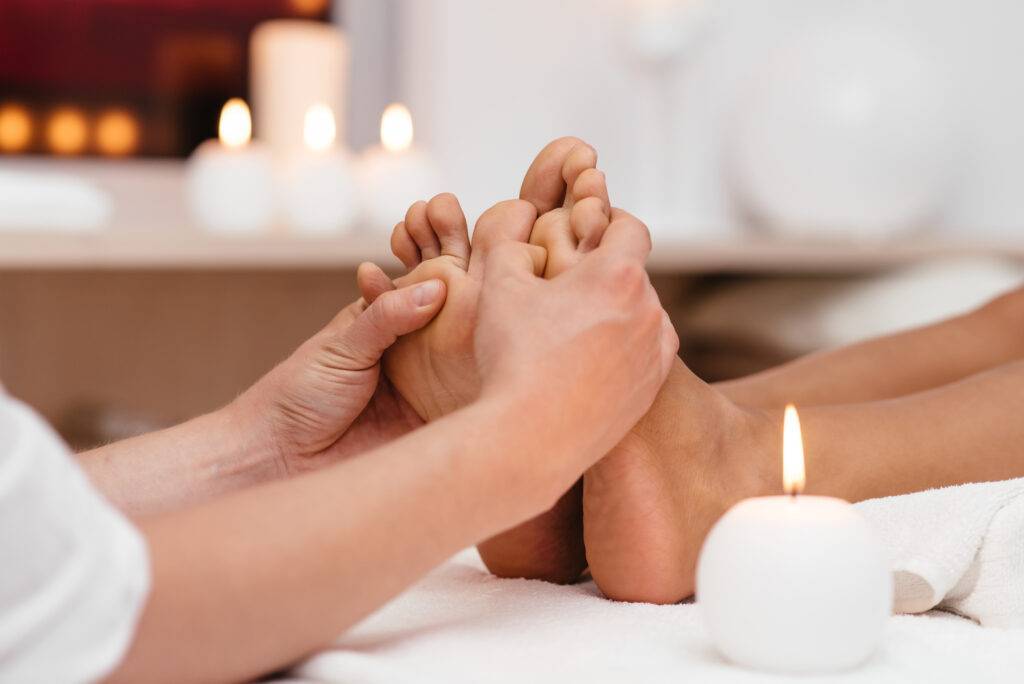Have you ever heard of reflexology massage, a therapy in which different amounts of pressure are applied to certain parts of your foot?
It claims the capacity for relief from sinus problems to pangs of labor.
Understanding Reflexology Massage
The theory underlying reflexology states that the feet, hands, and ear represent the entirety of the body, with each point identical to corresponding organs or systems.
Practitioners of this therapy utilize massage techniques to stimulate certain reflex areas to improve the exchange of energy and facilitate healing on one’s own.
The practice is over two millennia old and can be traced back to civilizations such as China and Egypt. Western people recognized it as a complementary therapy in the twentieth century.
A reflexology session involves a skilled healer who uses their fingers, thumbs, and sometimes specialized implements to apply pressure to specific points in the feet, hands, or ears.
It’s a soft and discreet remedy meant for the relaxation of muscles, enhancing blood flow, and stimulation of self-restorative features of an organism.

The Power of Balance
Reflexology has its aim, among other things, to assist people in finding equilibrium and oneness at an individual level (internal).
Instead, it takes a more wholesome route by targeting specific reflex points involved in different organs and systems to improve their functionality, eventually enhancing well-being.
When the body’s hormones are balanced, it can withstand stress, prevent illnesses, and function at its best.
Reflexology could be significant in supporting standard medical treatment, especially for people facing long-term health challenges.
How Does it Work?
A reflexologist uses their hand pressure into particular places on the foot that correspond to troubles with pain and discomfort.
Imagine the calming feeling that comes with someone else massaging your feet. It creates relaxation and tranquility in us. The gains of using the process of reflexology have been equivalent to those related to the traditional foot treatment since its proof of some added benefits is minimal.
The fight-or-flight response of the sympathetic nervous system is activated when you are anxious or stressed.
Foot massages start the parasympathetic system, enabling you to attend to your daily chores without distraction.
Notes Bodner, “The parasympathetic system is the relaxation response in which the body tries to conserve itself by keeping an even keel.” “To see you thrive optimally and thus serve you rightly.”

What conditions might reflexology help with?
While there is limited scientific evidence showing the superiority of reflexology over a foot massage, proponents of reflexology suggest it may offer potential benefits in the following areas:
- Immune system
- Colds or bacterial infections
- Sinus issues
- Back pain
- Hormonal imbalances
- Digestion
- Arthritis pain
What are the benefits?
Reflexology massage offers several potential benefits, including:
- Stress Reduction: Stimulating reflex zones in the body leads to relaxation, lower stress levels, and improved emotional condition.
- Pain Relief: Reflexology has become helpful in easing different types of pains, especially those that emanate from the skulls, spikes at the backs, and joints for many people.
- Improved Circulation: This therapy can also improve blood flow, thus helping in some other health conditions.
- Enhanced Energy Flow: Reflexology enhances the body’s energy flow, facilitating natural healing by stimulating reflex points.
- Better Sleep: In reflexology, it is observed that some people have better sleep qualities and cycles.
- Balanced Body Systems: In this regard, reflexology may help balance various body systems and organs that affect an individual’s health.
- Complementary Therapy: It is a complementary therapy in many health conditions.
- Relaxation: The most apparent advantage of reflexology is that it induces relaxation, making it a soothing and reliever therapy.

The Reflexology Experience
If you’re considering trying reflexology, here’s what you can expect during a typical session:
Consultation: Typically, your reflexologist would start with an initial session where you talk about what you want to achieve through reflexology and any specific health concerns. It ensures that they conduct the session based on your requirements.
Comfortable Setting: It is usually done in a serene and peaceful atmosphere. As a patient, you will wear only shoes and socks and lie in a relaxing chair or a unique massage table during this therapy method.
Technique: Reflexologists use their fingers to exert pressure in specific spots across your feet, palms, and ears. The pressure is sturdy, without causing any pain, and it is pleasurable.
Duration: The standard time for a reflexology session is around 50-60 minutes.
After Effects: After a session, many individuals feel soothed and revitalized. You can plan for a quiet time afterward, as you will likely feel drowsy.

Should you try it?
Indeed, it is possible to state that attempting reflexology might be a fantastic experience on the way to a healthy and renewed life.
The ancient roots of this complete practice are replete with advantages like reduced stress, better sleeping patterns, pain alleviation, and general thriving of the entire body.
Reflexology is a gentle, non-surgery, soothing therapy to improve your body’s health daily.
Therefore, when it comes to unwinding, relaxation, good sleeping habits, and self-treatment, explore reflexology as a gentle but rewarding therapeutic approach for enhancing life.

